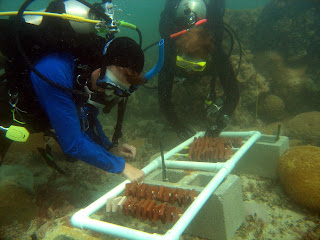
 Now that the new coral recruits are taking up the algal symbionts, our next step is to sample these corals and determine the type of symbionts that they are initially acquiring. Our goal is to determine if these are the same types of symbionts that the adult corals harbor and if not, to ascertain (1) when the assemblage that is found within the adult is established and (2) what is the basis for the type of symbiont that the the coral acquires doing its ontogeny. Here are photos taken by the staff at the UM Hatchery while they were doing the first sampling of the recruits. As you can see - the recruits look great!
Now that the new coral recruits are taking up the algal symbionts, our next step is to sample these corals and determine the type of symbionts that they are initially acquiring. Our goal is to determine if these are the same types of symbionts that the adult corals harbor and if not, to ascertain (1) when the assemblage that is found within the adult is established and (2) what is the basis for the type of symbiont that the the coral acquires doing its ontogeny. Here are photos taken by the staff at the UM Hatchery while they were doing the first sampling of the recruits. As you can see - the recruits look great!


















